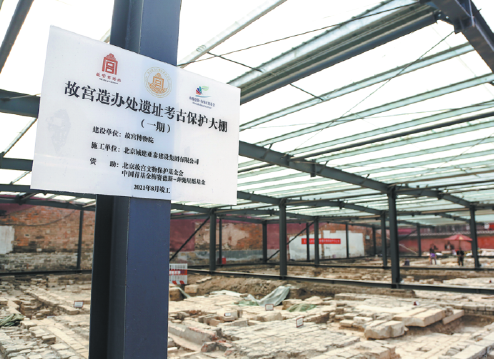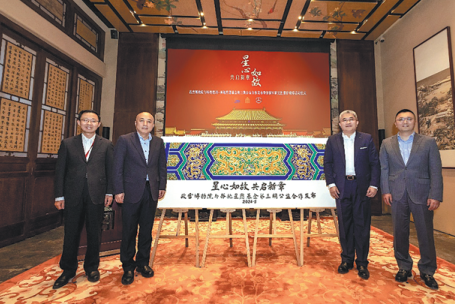Unearthing hidden stories of time in the underground Forbidden City

The Palace Museum in Beijing is preparing an archaeological exhibition in 2025 to showcase the latest discoveries of its Imperial Workshop architectural site and celebrate the centenary of its founding.
Covering some 720,000 square meters and also known as the Forbidden City, the Palace Museum used to be China's imperial palace from 1420 to 1911, spanning the Ming (1368-1644) and Qing (1644-1911) dynasties.
The Imperial Workshop, or Zaobanchu in Chinese, was a specialized institution of the Qing Dynasty for crafting objects such as clocks as well as precious material like jade and gold.
With the support of the Mercedes-Benz Star Fund, the Palace Museum started excavations of the site at the end of 2020.
Away from the crowds of tourists, the project has been progressing discreetly. But archaeologists have uncovered some exciting remnants that shed light on the historical development of the Forbidden City.
A highlight is four brick sangdun from the early Ming Dynasty. Sangdun, or cornerstone, is a type of ancient architectural foundation structure, primarily built under pillars to enhance stability.
Standing 4.45 meters long and 4.4 meters wide, these sangdun are among the largest of their kind in China, much bigger than the ones seen in the Forbidden City, according to Li Weiwen, a researcher from the archaeological department of the Palace Museum.
"The distance between the center of every cornerstone is 11 meters and we inferred that on each of them were four pillars, so you can image there once lay such a vast square palace," he said.
Li also discovered the cornerstones are surrounded by alternating layers of pounded bricks and rammed earth, which made up the building foundations to increase durability and stability.
"These findings have surpassed our imagination, demonstrating the building's grandeur and the superb architectural craftsmanship of ancient people," Li said.
Other unearthed relics included fragments of pottery, copper and tiles as well as animal bones, which offer a unique glimpse into the life of artisans in the Imperial Workshop hundreds of years ago.
"Archaeology demands great patience and persistence. At the Imperial Workshop architectural site, we spend most of our time on the crushed bricks and earth rather than those dazzling cultural artifacts.
"But thanks to them, we can peer into the history of the Palace Museum and even piece together what is not recorded in historical materials," he said.
"Based on our work, we hope to share with the public the stories of bygone ages, about the building construction and even about the cultural roots of Beijing and our country," he added.
Greater significance
The Imperial Workshop architectural site is the largest site discovered within the Forbidden City. It displays the most diverse remnants from times since the Yuan Dynasty (1271-1368), making it a crucial academic achievement, said Xu Haifeng, director of the department.
Beyond that, the relics of the Yuan Dynasty were important archaeological evidence for tracing the development of the Beijing Central Axis, which was inscribed onto the UNESCO World Heritage List at the end of July, Xu said.
Stretching 7.8 kilometers north to south through the heart of Beijing, the Central Axis is renowned as the backbone and soul of the capital.
It denotes an ensemble of landmarks that governs the overall layout of the city, including the Bell Tower and Drum Tower, Forbidden City, Tian'anmen Square Complex, and Yongdingmen Gate.
The Central Axis was initially established in the 13th century and formed in the 16th century. Over the centuries, the building complexes have undergone reconstruction and renovation, but the layout and functions of the axis as a whole have been preserved. It continues to influence Beijing's urban development and the lives of residents.
It is not only the spatial axis of the capital but the cultural axis and development axis, highlighting Beijing's exceptional status among ancient capitals worldwide. It showcases China's sustained efforts in protecting and promoting cultural heritage, scholars said.
Conservation projects and archaeological research on heritage sites have not ceased since 1978, and open areas have been gradually expanding, enabling more people to learn about the culture behind the axis.
The UNESCO inscription demonstrates the continuity, innovation, unity, inclusiveness and peaceful nature of Chinese civilization; it marks a milestone and a new beginning for the protection of the Beijing Central Axis, said Chu Jianhao, deputy director of the Beijing Cultural Heritage Bureau.
"We will adhere to the World Heritage Convention and draw on international experience in World Heritage Site protection to advance the comprehensive conservation of the old city of Beijing based on the Central Axis," he said.
Long-term commitment
Culture is the lifeblood of a city, a nation and a country, shaping their identity, values and traditions. Meanwhile, culture functions as a bridge, connecting people across time and space.
As the inventor of modern automobiles, Mercedes-Benz has a storied history spanning over a century.
"The future is driven by the past. We believe in the power of time and take great pleasure in bringing the value of cultural legacy to more people," said Zhang Yan, senior executive vice-president of Beijing Mercedes-Benz Sales Service and chairman of Mercedes-Benz Star Fund Management Committee.
As an international company with footprints in China, Mercedes-Benz established the corporate social responsibility partnership with the Palace Museum in 2018. Since then, the two sides have been implementing an array of collaborative projects, making remarkable achievements in the renovation of historical buildings, the protection of cultural relics, and archaeological and academic research, as well as cultural education and international exchanges.
Lou Wei, executive deputy director of the museum, said: "The Palace Museum serves as a bridge connecting the past, the present and the future."
"The Palace Museum has received support from all sectors of society in preserving cultural heritage and promoting traditional culture during the past century. Mercedes-Benz is one of our CSR partners who have been supporting us for many years. We look forward to strengthening our strategic cooperation to better protect the cultural treasures and pass them down through generations," he said.
Mercedes-Benz is willing to invest time and work with the Palace Museum to showcase the splendid Chinese civilization on the world stage, Zhang said.



Today's Top News
- Lawmakers review draft law to expand childcare services
- China's new-style tea brands find a hot new market in US
- Xi extends congratulations to Chilean president-elect
- Japan urged to stop provocative moves
- Shanxi ends province-wide blanket fireworks ban
- Tech park set to lift GBA's development






























